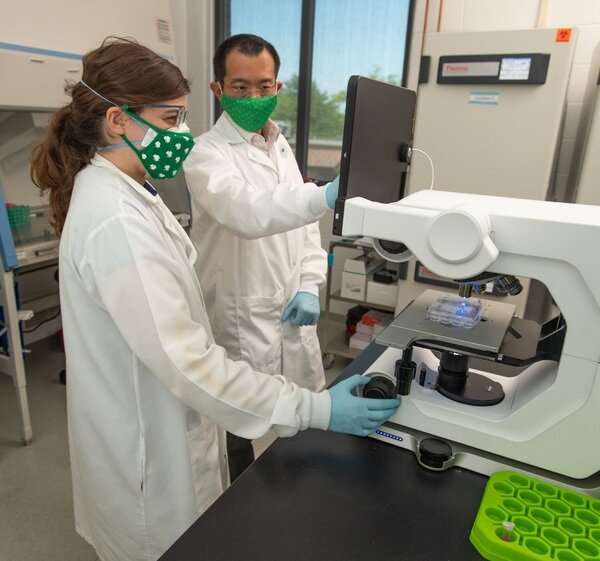Nanoparticle 'backpacks' restore damaged stem cells

Within a newborn's umbilical cord lie potentially life-saving stem cells that can be used to fight diseases like lymphoma and leukemia. That is why many new parents elect to store ("bank") their infant's stem cell-rich umbilical cord blood. But in the 6–15% of pregnancies affected by gestational diabetes, parents lack this option because the condition damages the stem cells and renders them useless.
Now, in a study forthcoming in Communications Biology, bioengineers at the University of Notre Dame have shown that a new strategy can restore the damaged stem cells and enable them to grow new tissues again.
At the heart of this new approach are specially engineered nanoparticles. At just 150 nanometers in diameter—about a quarter of the size of a red blood cell—each spherical nanoparticle is able to store medicine and deliver it just to the stem cells themselves by attaching directly onto the stem cells' surface. Due to their special formulation or "tuning," the particles release the medicine slowly, making it highly effective even at very low doses.
Donny Hanjaya-Putra, an assistant professor of aerospace and mechanical engineering in the bioengineering graduate program at Notre Dame who directs the lab where the study was conducted, described the process using an analogy. "Each stem cell is like a soldier. It is smart and effective; it knows where to go and what to do. But the 'soldiers' we are working with are injured and weak. By providing them with this nanoparticle 'backpack,' we are giving them what they need to work effectively again."
The main test for the new "backpack"-equipped stem cells was whether or not they could form new tissues. Hanjaya-Putra and his team tested damaged cells without "backpacks" and observed that they moved slowly and formed imperfect tissues. But when Hanjaya-Putra and his team applied "backpacks," previously damaged stem cells began forming new blood vessels, both when inserted in synthetic polymers and when implanted under the skin of lab mice, two environments meant to simulate the conditions of the human body.
Although it may be years before this new technique reaches actual health care settings, Hanjaya-Putra explained that it has the clearest path of any method developed so far. "Methods that involve injecting the medicine directly into the bloodstream come with many unwanted risks and side effects," Hanjaya-Putra said. In addition, new methods like gene editing face a long journey to Food and Drug Administration (FDA) approval. But Hanjaya-Putra's technique used only methods and materials already approved for clinical settings by the FDA.
Hanjaya-Putra attributed the study's success to a highly interdisciplinary group of researchers. "This was a collaboration between chemical engineering, mechanical engineering, biology and medicine—and I always find that the best science happens at the intersection of several different fields."
The study's lead author was former Notre Dame postdoctoral student Loan Bui, now a faculty member at the University of Dayton in Ohio; stem cell biologist Laura S. Haneline and former postdoctoral fellow Shanique Edwards from the Indiana University School of Medicine; Notre Dame Bioengineering doctoral students Eva Hall and Laura Alderfer; Notre Dame undergraduates Pietro Sainaghi, Kellen Round and 2021 valedictorian Madeline Owen; Prakash Nallathamby, research assistant professor, aerospace and mechanical engineering; and Siyuan Zhang from the University of Texas Southwestern Medical Center.
The researchers hope their approach will be used to restore cells damaged by other types of pregnancy complications, such as preeclampsia. "Instead of discarding the stem cells," Hanjaya-Putra said, "in the future we hope clinicians will be able to rejuvenate them and use them to regenerate the body. For example, a baby born prematurely due to preeclampsia may have to stay in the NICU with an imperfectly formed lung. We hope our technology can improve this child's developmental outcomes."
More information: Loan Bui et al, Engineering bioactive nanoparticles to rejuvenate vascular progenitor cells, Communications Biology (2022). DOI: 10.1038/s42003-022-03578-4
Journal information: Communications Biology
Provided by University of Notre Dame




















